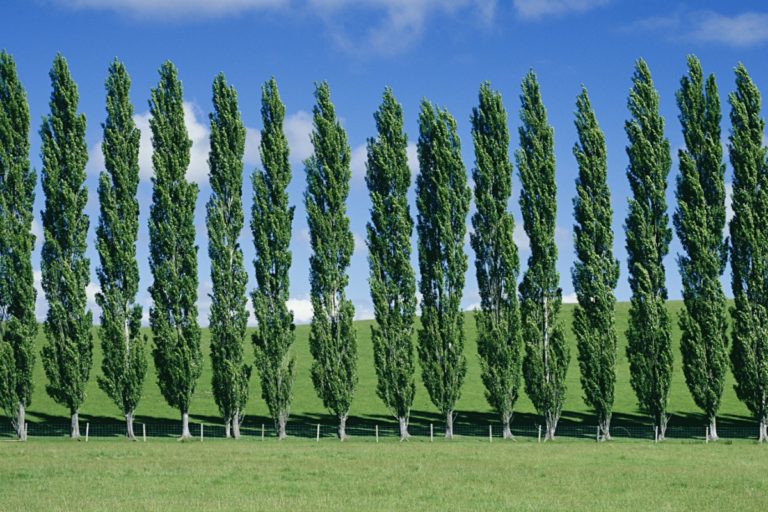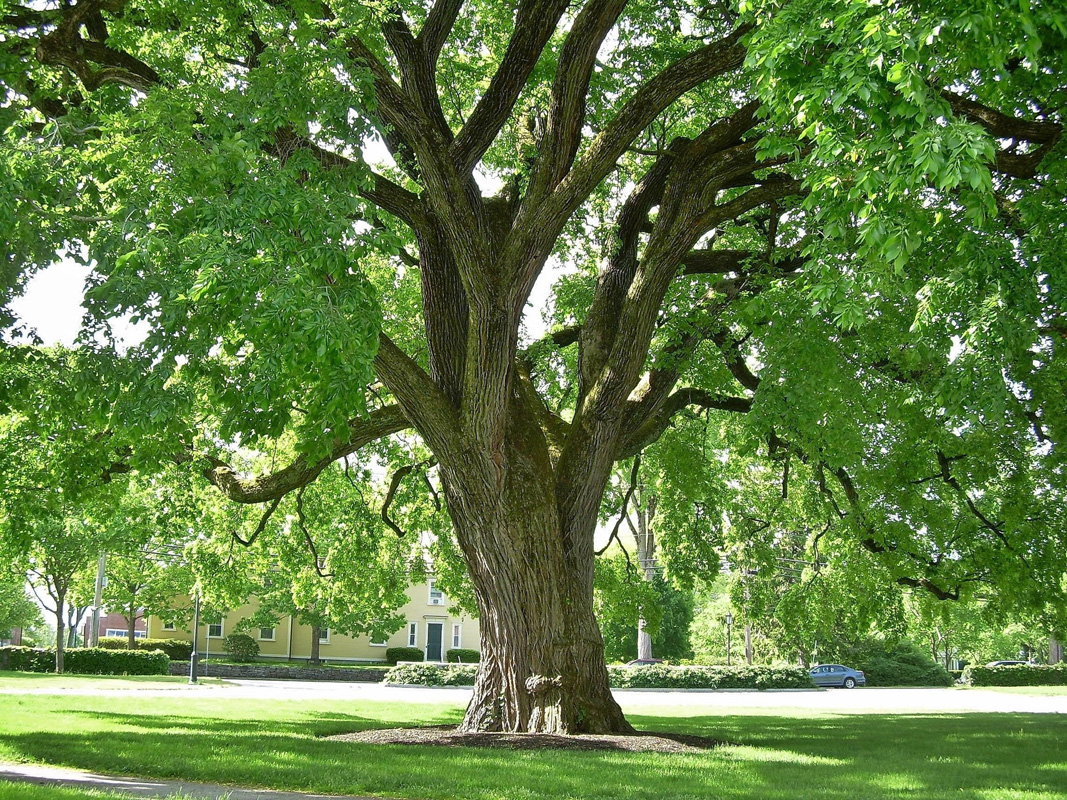The trees that grow on your backyard and lawn are statement pieces for your property. This is why you should take great care in selecting what type of trees grow around your home. You may choose to plant a single stately ash tree for majestic foliage or you may wish a copse of fragrant persimmon trees for delicious fruits.
But what if you want to plant something a little more dramatic?
You can’t go wrong with statuesque poplar trees. Today, learn why you may want to plant poplar trees on your property, what are the different types of poplar trees as well as some diseases you should look out for in case you need to do some basic tree care.
Poplar Tree History
The poplar genus of trees, belonging to the willow family and native to the Northern Hemisphere, comprises 35 species. North American poplars are categorized into three distinct groups: cottonwoods, aspens, and balsam poplars. As noted by its name -Populus- these were predominantly planted near public areas in Roman times. Its softwood texture is mainly used for making cardboard boxes, crates, and paper or veneer production processes.
According to Greek mythology, Hercules was celebrated with a white poplar after triumphed over Cacus. As an emblem of victory and a peaceful afterlife for the deceased, Ancient Greco-Roman society held this tree in high reverence. Indeed, even today, people recognize its bloom as signifying time – honoring those they have lost and cherishing every moment that remains.
The genus Populus is a popular landscaping tree across the United States. Nicknamed “Poplars,” “Cottonwoods,” or “Aspens,” these trees are commonly planted due to their fast-growth rate ranging from 50 feet up to an impressive 160 feet tall. Furthermore, they’re widely used for manufacturing, such as plywood production and wood pulp creation.
Poplar trees are beneficial and practical. They also boast beautiful aesthetics. The trees have fastigiated growth patterns—essentially growing straight up in a columnar fashion — which adds to the charm of gardens across America. This style has become so trendy that many look for alternatives such as Sky Pencil Trees to get this aesthetic for their landscape or garden; it’s suitable for formal settings just as casual ones! Moreover, these trees require minimal maintenance and no necessary pruning – making them an ideal choice among busy landscapers and gardeners wishing to “plant and go.”
Two iconic poplar species of Eurasia are the white and black varieties. The white poplar is commonly known as silver poplar because its leaves have a felted, white underside. Alternatively, it’s called maple leaf poplar for its leaves’ lobed margins. This majestic tree can reach up to 30 meters in height and has an expansive or columnar form.
Why Plant Poplar Trees?

Poplar trees are tall and elegant members of the willow tree family. Unlike the wide and cyclopean cedar trees, the profile of a poplar tree is slim and stately, almost like an oversized feather or a champagne flute in its stature.
But there are tangible benefits to planting a stand or a row of these elegant trees on your property.
For decorative purposes.
As previously mentioned, poplar trees are very elegant, evoking imagery of the hills of Rome and majestic avenues lined with tall trees. Imagine planting a line of poplars along the edge of your property or on the side of a long driveway and you can see the instant appeal. A few poplar trees can be a great way of increasing your home’s resale value.
To cool down the property.
There is scientific proof that planting a few trees on your property can be a great way to cool it down. This occurs thanks to a process known as transpiration cooling. Tree leaves release water into the air and this moisture acts as coolant. You may be pleasantly surprised by how cool your entire property can be with a few trees around it.
To help the environment.
More and more people are becoming concerned about the environment and these kinds of property buyers may look favorably to poplar trees. If you’re thinking of reselling your property and want to attract more buyers, these trees may provide the ideal backyard improvement idea you’re looking for.
What are the Types of Poplar Trees?

There are 35 species of poplar trees in the willow family and they are all native to the Northern Hemisphere. But the different types of poplar trees native to North America can categorized into three groups: balsam poplars, cottonwoods and aspens.
Below are three specific types of poplar trees. Some of them are suitable for planting in your yard and others are better off if left in the wild. Learning about their features can help you make an informed decision should you decide to grow poplar trees on your property.
White Poplar Tree
White poplars are probably the least suitable type of poplar trees for garden landscapes. The defining features of a white poplar tree are its fluffy flowers, which is reminiscent of cotton. This white, fluffy down can be very annoying when in full bloom and makes quite a mess. Another reason white poplars aren’t ideal for growth on a residential property are their roots. These poplars have very aggressive root systems that can infiltrate basements, tear up your driveway and make your lawn look like a total mess. The bark of white poplars have smooth grayish green looks, with diamond markings all over it.
Black Poplar Tree
Black poplars are large and imposing members of the species. The trees get their name from their dark colored bark. These poplar trees also produce some truly spectacular flowers. Male poplar trees produce red flowers while their female counterparts produce slightly yellow green flowers. While the flowers of black poplars can be quite fetching, the same cannot be said for the wrinkled, furrowed bark that gives them their name. Black poplars can also grow to unwieldy girths and heights overtime. The key to maintaining black poplars is to continuously prune it and call expert tree care providers to ensure it doesn’t grow too big for your entire property.
Lombardy Poplar Tree
The most elegant of all the types of poplar trees, Lombardy poplars reach for the sky like oversized paintbrushes or lush feathers. These tall, slim trees can reach up to 50 feet tall if left undisturbed and well-fed. Lombardy poplars are great for creating organic privacy hedge between properties. However, planting Lombardy poplars also has its downsides. The trees shed fluffy white seed hairs during the summer, making it a messy addition. It also has a shallow root network that remains on the surface, meaning they can ruin your lawn.
How To Grow A Poplar Tree
Homeowners often opt for planting poplar trees as these American natives quickly bring stunning shade and beauty into any garden. Like growing a coconut tree, caring for a poplar tree is straightforward in its optimal environment. Poplars require nutrient-rich soil with an acidic to neutral pH level, exposure to direct sunlight, and ample water supply to keep roots hydrated.
Planting a Poplar Tree
The best times to plant your poplar are in the spring and early fall, as you should avoid planting it during the hot summer months. Ensure its location has full sun exposure and plenty of space to grow without obstructions. Here are the steps for planting a poplar tree.
- Step 1 – When planting your sapling, dig a hole with twice as much width and depth as the tree’s root ball.
- Step 2 – Unpot it carefully, and gently untangle any surrounding roots.
- Step 3 – Place some soil mixed with compost or manure in the bottom of the hole before settling in your new sapling so that its top is aligned to ground level when finished backfilling with an earth-compost blend.
- Step 4 – Mulch around it using bark chips or another organic mulch for insulation against weather extremes.
- Step 5 – Make sure you water every few days during the first weeks following planting.
- Step 6 – Reduce the watering frequency as new growth appears on stem tips!
Poplar Tree Growing Conditions
Planting hybrid poplar trees or any other varieties requires proper care and attention, especially if you want them to reach their full potential. Poplars need nutrient-rich soil (be it acidic or neutral), direct sunlight, and the right amount of water for their roots to be adequately hydrated. It’s important to remember that these majestic trees can range anywhere from 50 to 165 feet in height with a trunk circumference of up to eight feet – so make sure your tree has enough space before planting!
Poplar trees are susceptible to various diseases and pest infestations. These include leaf miners, root rot, aphids, cankers, and verticillium wilt. It is essential to plant in areas with good drainage and plenty of sunlight to prevent these issues. Regular pruning and fertilization are also necessary to keep your poplar healthy.
Environmental Changes
Poplars are also sensitive to environmental changes like drought or excess water. If too much water is present, the tree will become susceptible to root rot or fungus growth; meanwhile, a lack of moisture can cause leaves and branches to dry out. To maintain healthy growth and combat any potential issues, it’s essential to water your poplar regularly and provide proper nutrition.
Type of Species
Furthermore, the type of species you choose will also affect the tree’s health and growth rate. Hybrid poplars are known for their faster growth rate than other types and are more tolerant of environmental changes, making them a great choice.
Poplar Tree Companion Plants
Planting various crops harmoniously in the same garden is known as companion planting, a method that can significantly improve your product’s health and abundance. This practice has numerous advantages; it fully uses limited gardening space and helps deter pest infestations and diseases. Companion planting maximizes productivity while nurturing fresh vegetables – perfect for any conscientious gardener!
Some of the best companion plants for poplars are herbs and ground-covering plants, such as clover, thyme, oregano, and chamomile. This help regulates soil temperature, which can ultimately affect your tree’s health. Legumes are also beneficial as they enrich the soil with nitrogen – an essential nutrient for promoting healthy growth. Planting herbs next to your poplar will also help deter pest infestations by masking their smells and attracting beneficial pollinators such as bees and butterflies. Finally, companion plants act as a natural weed barrier, reducing weeding time significantly!
Choose plants that are both beneficial for your poplar and aesthetically pleasing. Try herbs such as rosemary or thyme if you’re looking for low-maintenance options. These require minimal care but will help to regulate soil temperature and pH levels of the surrounding area.
Additionally, be careful with fertilizer selection; opt for those specifically designed for companion planting, as these offer the ideal balance of nutrients. Finally, water your plants regularly and provide adequate space for their growth – this will ensure you get the most out of your companion planting!
What are Common Poplar Tree Diseases?

Like all plants, poplar trees need a certain amount of maintenance and tree care. If you do grow some poplars on your grounds, here are some of the common poplar tree diseases you should look out for.
Rust
This appears as small spots of orangey spores on the leaves of poplar trees. Although it may look a little alarming, you don’t need to do anything because they aren’t damaging to the trees and they’ll remain healthy.
Scab and Shoot Blight
If you notice that the tips of young branches and leaves quickly rot to black, your poplar may have scab and shoot blight. The spores of this disease look like olive residue on the surface of dead plant tissue. It affects smaller trees more often than mature specimens. The only way to control this is to prune all the affected branches or even remove infected trees entirely.
Cytospora canker
A very alarming infection, this disease causes large branches to die and huge, brown cankers to appear on the bark. When it rains or the weather gets wet, yellow ooze with leak out of the cankers. Lombardy poplars are especially prone to these cankers. The only solution is to remove infected areas and to gouge out any cankers.
Hypoxylon canker
Bark cankers are destructive to quaking and big-tooth aspen, sometimes affecting balsam poplar trees too. Symptoms of this condition include sunken areas with yellow-orange borders along irregular edges, followed by blistering, resulting in bark shedding away from the tree. Fortunately for us, Eastern cottonwood trees have not been affected yet.
Wetwood
Lombardy poplar trees are especially vulnerable to this disease. It is characterized by a water-soaked appearance, darkening in color from white to brownish-red on the trunk and branches, and an unpleasant smelling fermentation odor. Unfortunately, the death of entire trees due to premature declining health often occurs.
Aphids
A range of aphid species can be spotted on Poplar trees, but you have the power to take control. Imidacloprid applied as a systemic that is taken up by roots works great for all types of these bugs. For non-gall forming ones, acephate or insecticidal soap are also recommended solutions. To ensure proper results, read the label carefully before use and follow dosage rates and safety instructions accordingly!
Cottonwood leaf beetle
This beetle, slightly larger than a quarter of an inch in length, is unmistakable for its yellowish-hue and black stripes or spots spread across its wings. Appearing early in the springtime months, they feast on burgeoning shoots while their female counterparts lay their yellowish eggs clustered beneath leaves. The grubs that soon emerge cause unsightly skeletonization upon these same leaf surfaces. It’s estimated that three to four generations can take place within one season alone!
Poplar borer
During the summer months of July and August, eggs are inserted into slits in poplar bark by this long-horned beetle’s larvae. These young borers then begin to burrow their way through inner bark and sapwood, eventually making larger tunnels as they progress deeper into the wood – a process that takes three years before completion. As a result, trees experience blackened swellings at the sites of infestation where these creatures have tunneled through their trunks or branches.
Benefits of Poplar Trees in the Home
There are several benefits to planting a poplar tree in your backyard. These include the following:
- Quick Growth – Poplar trees can grow up to 6 feet annually, providing rapid shade and privacy to your home.
- Versatility – These trees are incredibly versatile, as they can thrive in almost any location — from full shade to full sun — and soil type.
- Pollution Control – Poplar trees are naturally adept at filtering air pollutants, making them excellent for reducing smog levels in urban environments.
- Multi-Seasonal Splendor – The trees’ foliage transitions from yellow in autumn to green in spring and summer, giving your garden a vibrant look throughout the year.
Fertilizing Poplar Trees
To ensure your poplar tree’s healthy and strong growth, apply 10-10-10 fertilizers three to four times during spring. This is especially effective while the tree is still young. Meanwhile, an older or mature poplar doesn’t necessarily have to receive additional fertilizers – but it can’t hurt either!
Poplars are known to be intense nutrient absorbers, removing soil nutrients from nearby turf and ornamental plants. To keep them healthy each fall, fertilize 1½ times as far out from the tree’s trunk than its drip line – for instance, if it’s a 10-foot poplar, you should spread fertilizer up until 15 feet away from it its base.
Measuring the amount you use is essential to keep your fertilizer away from the foliage or trunk. For poplars with a trunk diameter of 1/2 inch at the base, begin using ½ pound of fertilizer; for larger trees, apply one pound per each inch in width. It is also important to remember that no fertilizer should be applied when planting a tree or during its first season!
Deciding between organic and synthetic fertilizers can take time and effort for gardeners. Each type has advantages and disadvantages, sparking a fiery debate among growers regarding which product best suits their needs. Here are the two main types of fertilizers and what they can do for your poplar tree.
- Organic Fertilizer – Organic fertilizers provide an excellent source of nutrients while also helping to improve soil structure, making it more conducive for root growth and nutrient absorption. They are also generally safer for the environment as they don’t cause chemical runoff like their synthetic counterparts. One considerable drawback of using organic fertilizer is the cost. They also take time to break down in the soil, making their effects slower and less dramatic than synthetic fertilizers.
- Synthetic Fertilizers – Synthetic fertilizers are cheaper than organic ones and provide an immediate boost in nutrients to the soil. However, these can damage the environment if used excessively or carelessly. They also lack the long-term benefits that organic fertilizers provide for root growth and structure, making them a less ideal choice in the long run. They also do not support the long-term health of your soil.
Precautions and Safety Measures for Handling and Storing Fertilizers
When handling or storing fertilizer, remember to take specific safety measures.
- Before applying anything, read the instructions and follow them carefully.
- Avoid spreading fertilizer near bodies of water, as this can cause contamination and harm wildlife.
- Wear gloves, long-sleeved shirts, and long pants when applying fertilizer to protect your skin from contact with any hazardous materials.
- When storing, keep the fertilizer in a cool and dry place out of reach from children and pets.
- Always clean up your workspace after use to prevent accidents or mishaps.
Pruning And Pollinating Poplar Trees
Pruning and pollinating are important steps in ensuring the health of your poplar tree.
Pruning
Pruning helps to remove dead, dying, or diseased branches, which can otherwise become hazardous to those around the tree. It is also necessary for keeping its structure open and promoting healthy growth.
Pollinating
Pollination is an essential part of propagating poplar and ensuring their survival. Most poplar trees are monoecious, meaning they have both male and female flowers on the same tree. To increase your chances of successful pollination, it’s crucial to plant two different varieties nearby or even within the same garden.
Finally, it is essential to remember that pruning should always be done in the late winter or early spring when the tree is still dormant. By doing this, you’ll be able to promote new growth and achieve a well-structured tree form with no competing branches. Also, pollination should occur during mid-spring when flowers are in full bloom.
Hand pollination is a process that involves manually transferring pollen from male flowers to female flowers of the same species. This technique can be used when there aren’t enough natural pollinators or you want more control over the process. To successfully hand-pollinate, use a soft brush to lightly touch the male and female flower parts to transfer the pollen.
To manage pests that can affect pollination, always check for signs of damage on leaves and branches. Common pests include aphids, scale insects, caterpillars, beetles, and spider mites. If you find any evidence of infestations, use an insecticidal soap or oil-based products to remove them. It’s also essential to ensure your poplar tree has enough water, sunlight, and nutrition to maintain its health.
10 Effective Tips And Precautions While Growing Poplar Tree
Here are ten practical tips and precautions you should observe when growing a poplar at home.
- Choose the right species: Before you plant a poplar tree, ensure it suits your climate and soil type.
- Plant during the right season: Planting during autumn can help avoid hot summer temperatures that can cause root damage in young trees.
- Dig a wide hole: When planting, create a hole wider and deeper than the root ball of your sapling.
- Stay away from paved areas: Plant your tree at least 10 feet away from pavement and other hard surfaces to prevent damage from de-icing salt.
- Provide adequate soil nutrition: Poplars require nutrient-rich soil for optimal growth, so apply fertilizer as needed.
- Monitor water levels: Poplar trees are sensitive to drought and overwatering, so make sure you provide the right amount of moisture for your tree’s needs.
- Protect from weather extremes: Cover young saplings with bark chips or other organic mulch for insulation against harsh temperatures.
- Prune and pollinate: Regular pruning and hand pollination can help ensure healthy growth.
- Control pests: Inspect your tree for signs of insect infestations and use suitable methods to remove them.
- Clean up your workspace: Always clean up any fertilizer or mulch after applying it to prevent accidents or mishaps.
Importance of Regular Maintenance and Care for Poplar Trees
Regular maintenance and care are essential for keeping your poplar tree healthy. This includes providing adequate water, nutrition, sunlight, and regular pruning and pollination to promote strong growth. Additionally, controlling pests and monitoring soil health can help maintain its environment. Finally, cleaning up your workspace after applying fertilizer or mulch is also crucial for safety. Following these simple steps can ensure a healthy and productive poplar tree!
Conclusion
Poplar trees are a great option for homeowners because they’re easy to care for and can be planted in many climates. However, it is essential to remember that proper maintenance and care must be taken when growing poplar. This includes providing adequate water, nutrition, sunlight, and regular pruning and pollination to promote strong growth. Additionally, controlling pests and monitoring soil health can help maintain its environment. Finally, always remember the importance of regular maintenance and care to ensure the healthy growth of your poplar tree!






